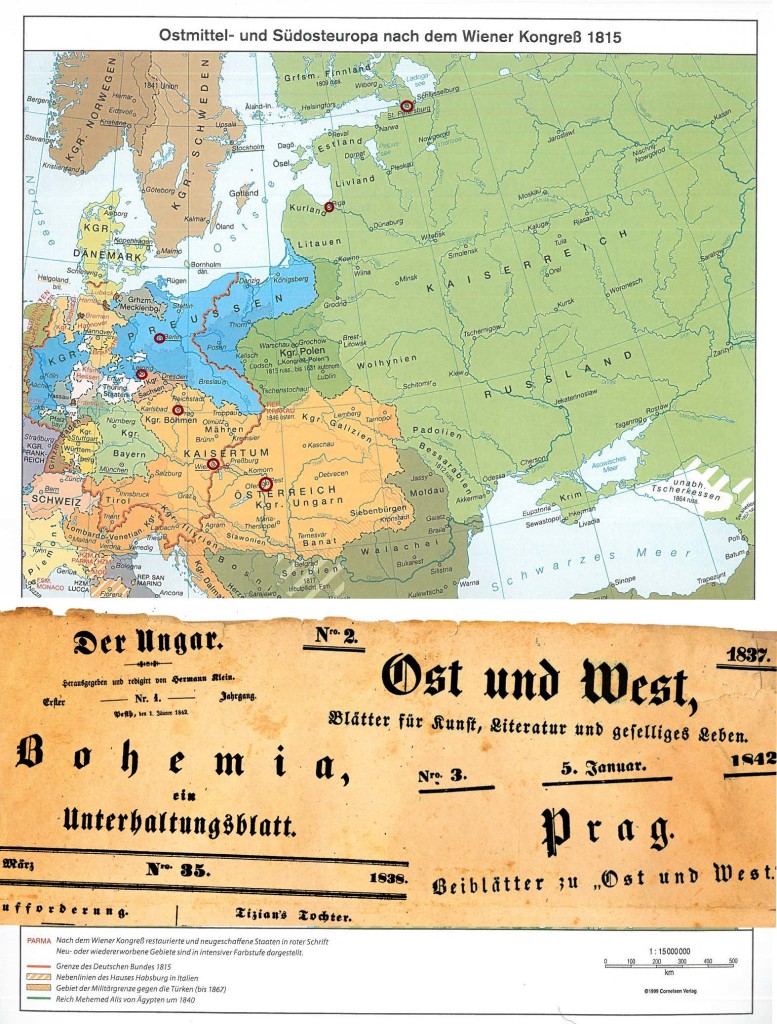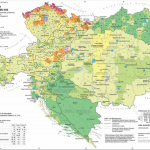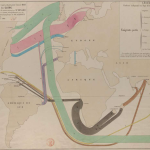Anna Ananieva and Rolf Haaser
Anna Ananieva / Rolf Haaser
Institute for Eastern European History and Area Studies at the Eberhard Karls University, Tubingen (Germany)
Research project „Circulation of News and Goods. The Transfer of Modern Urban Forms of Living in the German Speaking Press in Bohemia and Hungary, 1815-1848“
Webpage: http://www.uni-tuebingen.de/fakultaeten/philosophische-fakultaet/fachbereiche/geschichtswissenschaft/seminareinstitute/
osteuropaeische-geschichte/forschung/forschungsarbeiten/zirkulation-von-nachrichten-und-waren.html
Case Study
“Floods as Transnational Media Events: Mapping of Dispersed Public in the Flows of Communication in the Cases of Natural Disasters in St Petersburg 1824 and Buda and Pest in 1838.”
The study is considered a contribution motivated by cultural studies and media history adding to the discussion on transnational approaches which are taken by a spatial historiography. It looks at the topic of flooding in urban space and focuses on two outstanding examples from the first half of the 19th century: 1) the storm tide of November 1824 which caused backwater in the Neva and flooded huge parts of St Petersburg, and 2) the ice drift of the Danube in March 1838, a flood disaster which destroyed a large part of the prosperous merchant city of Pesth (Pest) and the suburbs of the residence of the Hungarian Palatine in Ofen (Buda). Due to their consequences, these two catastrophes take a special place in the urban, cultural, and political history of the early 19th century. Besides the royal seats of the Russian Empire and the Habsburgian Kingdom of Hungary, this study includes Prague as a third capital into its realm of observation. In the case of the Bohemian residence, the study does not explore yet another flooding, so e.g. of the Vlatva, as an additional, third event of catastrophe, but focuses on the perception of these two geographically distant flood catastrophes in the Prague press and the reactions in the general public.
In two regards this study enters unknown territory. It moves geographically within a triangular constellation between St Petersburg, Prague and Buda-Pest and covers a period of time which – anyways being marginalised as Biedermeier or Vormarz-era – has not yet been seriously taken into consideration for the exploration of natural catastrophes. Also the media-historical approach of the study, i.e. to explore the medial representation of two transnational media events primarily by analysing the empirical material of a single medium, namely the German speaking “Prague Newspaper” (Prager Zeitung) and the affiliated entertainment journal “Bohemia”, has – as far as we now – no equal in the historic research on catastrophes.
The study demonstrates that these flood disasters were constructed as media events within transnational communication. Although Prague, as Bohemia in general, was not affected by the storm or the flooding, the editor and publisher of the “Prague Newspaper” felt it necessary to depict the current landscape of flood disaster which had its starting point at the Upper Rhine and spread to the shores of the Neva. A geographically wide-scattered net of correspondents, which was used for the news coverage of the German speaking newspapers, made it possible for a broad readership to create a mental map of Central Europe shaped by the current catastrophe scenario and to really internalize it through the regular reading of the news. A forerunner of modern entertainment journalism – so the thesis of this paper – had a considerable stake in the emergence of this mental map.
Established as transnational media events, these flood disasters contributed to the imagination of a pan-European space. Viewed in this context, the study seizes on the question to what extent the handling of catastrophic natural phenomena in the first half of the 19th century influenced the self-image of an imagined community of urban elites in Europe. Here the study resumes the model of “dispersed public” which has become common in the past years within the communication and media studies. For the political daily press as well as entertainment journals did not only produce depictions of catastrophes but they also had the potential to bring about social integration as well as to generate empathy and altruism. In regard to the donation campaigns and fund-raisers, the study focuses on cultural practices of charity which, as practical action caused by a current catastrophe, mark the contribution of non-governing but elitist social classes in public events.
Focusing on two devastating floods in the urban space, the study shows that the dispersed public in Central and East Europe during the first half of the 19th century experienced effective impulses of a flow of information which increased rapidly at that time. This enables the researcher to regard the European world as a European space of communication. This view could emerge simultaneously with the different efforts of creating and firmly establishing national identity. Beyond the power-political realm, the medial networks, which were oriented towards transnationality, caused a certain perception and rehearsal of social and cultural practices which carried the sign of modernity and would not stop at national borders.
Research Project
The study proposed here emerged as a pilot study within the framework of a research project which is pursued at Tubingen University since October 2013. The topic of the research project is “Circulation of News and Goods. The Transfer of Modern Urban Forms of Living in the German Speaking Fictitious Press in Bohemia and Hungary, 1815-1848“. The research group consists of representatives of the Institute for Eastern European History and Area Studies and of the Ludwig Uhland Institute for Empirical Cultural Studies. The time plan for this project is two years and the planned date of completion is December 2015. The project is funded by the Federal Government Commissioner for Culture and the Media upon a Decision of the German Bundestag.
The project explores the period between 1815 and 1848 and asks which forms of modernity were developed with the help of entertainment on the cultural transfer line, which at the time connected the cities of Leipzig, Vienna and St Petersburg. Here, we are mainly interested in two intersections of this German speaking axis of communication: the cities Pest (Buda-Pest) and Prague. We focus on the fictitious press and its networks in order to exemplarily explore the processes of cultural transfer, which helped spreading new urban styles of living of the European “elegant world”.
The research project considers itself a contribution to transnational historiography and systematically connects within its approach the expertise from German, East European and South East European studies. It reconstructs a European topography of “sociable life” which developed and survived in interaction with the traditional forms of a cosmopolitan courtly society on the one hand and the efforts towards nation-states on the part of the bourgeois society on the other. The German speaking actors and media of entertainment in Bohemia and Hungary lie at the core of the studies. Questions will be discussed that focus on the transfer of knowledge on a modern urban style of living within a network of correspondents, which covered Pest and Prague, Leipzig, Vienna and St Petersburg. This gradually increasing circulation of news and goods will be explored by focusing on the press and on material culture. Personal networks and journalistic strategies will be reconstructed with the help of two central case studies of magazines in Hungary and Bohemia. Aim of the project is to trace within the German speaking press market the specific medial constellations of entertainment which were developed, implemented and also rejected through interaction of the imperial metropolises and the aspiring cities in Central Europe.
In the framework of the project, an online portal will be designed and established. This portal is aimed at depicting the German speaking press landscape according to the research questions of the project. Therefore we will bibliographically record the relevant journals, comment on them from a perspective of press history, and compile them systematically in a virtual library. At the moment we are looking for a suitable technical solution to combine the electronic resources and to adequately visualise the content of research in regard to the networks and mental maps.
Biographical note
Anna Ananieva is an assistant professor at the Institute for Eastern European History and Area Studies at the University of Tubingen, Germany. She acts as the leader of the project “Circulation of messages and goods”. Her research focuses on Russian and German literature and cultural history in the European context, and on transfer studies. Her recent studies cover the topics of press and publishing history, cultural and media practices of entertainment and sociability, and social constructions of elegance. She published four books, and was editor of two themed issues of journals, in particular: “Russisch Grün” (transcript 2010; Russian Green. Cultural Poetics of Garden in the Long 18th Century Russia); “Geselliges Vergnügen” (Aistehsis 2011; Sociable Pleasure. Cultural Practices of Entertainment in the Long 19th Century), “Räume der Macht” (transcript 2013; Spaces of Power. Metamorphoses of City and Garden in Early Modern Europe).
Rolf Haaser is aresearch fellow at the project “Circulation of messages and goods” at the Institute for Eastern European History and Area Studies at the University of Tubingen, Germany. Before that, he was aresearch fellow at the project „Von der ‚Aufklärung’ zur ‚Unterhaltung’: Literarische und mediale Transformationen in Deutschland zwischen 1780 und 1840“ (From ‘Enlightenment’ to ‘Entertainment’: Literary and Medial Transformations in Germany between 1780 and 1840) at the Institute for German Studies, Compared Literature and Cultural Studies at the University of Bonn, Germany. He published seven books and many articles on topics within the scope of his research interests, covering amongst others: Hessian literature history (17th-21st centuries); university history and student unions in the 18th and 19th centuries; public and secrecy: history of lodges and secret societies in the 18th and 19th century, entertainment journals round 1800; and unpublished works of Felix and Editha Klipstein.
Further Materials:
Map for Discussion:
Custom and Maker Session Proposals:
Custom Session
We would consider it helpful, to establish a discussion set on the topic “networks of elites: transfers of objects and knowledge in transnational spaces”. This topic appears to be relevant for a couple of participants of the workshop. Specifically there seems to be a common research interest with the projects of Alexander van Wickeren(Transfer of ‘Gundi’-Tobacco), Tom Cunningham (Missionaries of the Church of Scotland), Gero Tögl & Tobias Englmeier (Bayreuth Theatre Festival), Nico Randeraad, Christophe Verbruggen and Hans Blomme (Transnational Intellectual Cooperation in the long 19th century), Stefan Nygård (Scandinavian intellectuals), and Erdem Kabadayi (Organizations of Ottoman urban Neighborhoods).
On the basis of the concrete research projects the following key questions may be the subject for a common cross-project discussion:
How are we to proceed in order to reconstruct historical networks?
Which groups of actors who usually get lost sight of should be drawn into consideration?
Can there be specified certain types of social spaces that serve as privileged sites for the networks of the elites?
What sources prove to be especially rich (reliable / surprising) in the reconstruction of the transfer of objects (things)?
Can there (and if so, where) be designated significant differences between the early modern and more recent (modern) operations in knowledge transfer?
Maker Session
In the context of this section we would like to share information on how to use particular “tools”. We would like to get to know possible applications and to discuss their options and limits with colleagues who already have worked with them:
1) Specifically we are interested in approaches and experiences in the configuration of archive and library material to a work platform in the context of Virtual Research Environment (VRE) (abstract of the working group Genth / Maastricht: Nico Randeraad, Christophe Verbruggen and Hans Blomme).
We would like to learn and exchange ideas about how the practical research can shapedwith DARIAH (Digital Research Infrastructure for the Arts and Humanities) and CENDARI (Collaborative European Digital Archive Infrastructure), and what technical and human resources are necessary.
2) With regard to visualization of networks, we would like to know what the possibilities are in terms of application of sociological data analysis for historical research, in particular we would like to get to know the possibilities of “Connecting History and Space with VennMaker” by Martin Stark & Michael Kronenwett.

 Previous Post
Previous Post Next Post
Next Post
Anna and Rolf, I like your idea for the discussion in the custom session. Of course, my project moves more in the direction of mapping an individual’s movements (rather than social networks or objects per se) but there is clear overlap. A question is: As we trace the ‘transfer ‘ or movement of an object, or knowledge, or a human body, how is it possible to capture the qualitative change of that object, knowledge or body? It is a variation of the question how to capture the nature and character of social relationships in visual images… One to discuss perhaps.
My sense is that this is definitely a question to discuss. As important as I see the question of space (along with visualisation and mapping) coming into transnational and global histories, the kind of maps I can imagine lend themselves towards a “fixed”, “stable” objects or individuals that move through space – whereas they are not stable. As you rightly point out, Tom, this needs to be addressed that this is precisely what transnational history seeks to do: show not only the spatial variations BUT what these spatial variations do to objects and individuals that are changes and shaped through space, spatial movements and settings. This is something we should try to discuss if we seek to bring in space that, on the one hand, enhances our histories, while, on the other, must not simply them.
Dear Bernhard,
thanks for your response to the issue of changes of objects and individuals through spatial movements, raised by Tom in his comment on our abstract. In my response to Tom I have already implicitly reacted on your statement. At the moment I can only agree. Anna and I probably will take up the subject after a conference in Greifswald, which will keep us occupied till Friday this week.
Rolf
Dear Tom,
thanks for your comment. I must admit that we have not given much thought on the question of qualitative change of objects during transfer movements yet. Changes in the quality of media news in the flow from one country to another are much easier to trace.
Some thoughts after having read your abstract: Autobiographical sketches and travel accounts are very frequent in the journals and magazines we concentrate on in our Tuebingen project. I’m afraid we have not yet come to a convincing solution of how to visualize and/or map this sector of our research field. It looks as if we had an overlapping interest in this respect?
Rolf
Dear Anna, Rolf and Tom! Thanks a lot for your proposals. I really like your idea for the custom sessions, because it really touches issues that I am working on in my PhD. However, I would suggest to broaden the concept a little bit and not just to focus on “networks of elites”, but to include also non-elite actors. I give an example: Though my abstract rather focuses on scientific agricultural experts, I am aware that this agronomists were highly dependent not just on the practical knowledge of ‘simple’ farmers, but also on the trade networks that enabled tobacco farmers to exchange seeds and tobacco species f.e. in the french-german border area. Such exchanges and circulation can obviously not be framed by looking just to elites… Furthermore, I would take up and support Tom’s remark on the problem of “qualitative change” of things, actors etc. that we are investigating. I find this question really important and I think that it is also particularly fascinating to ask for possibilities to visualize such changes. All best, Alex
Dear Alexander,
thank you for your comment. Concerning the question of non-elite actors we are not so far away from each other, as it seems in the first place. Actually, we work with the concept of the so-called elegant world. This is not a sociological term in the sense of a definite social class. It rather includes all those individuals which are interested in the ideas and values disseminated by a press that addresses itself to the elegant world. This media concept functions to a great deal as a mere unrealistic (or imagined) optative [Wunschform] for a great part of the readership of the respective periodicals. Furthermore, the readership of entertainment journals are very often confronted with background informations on the products they are supposed to consume. Very often articles like these deal with the history and geographical origins of the products, as well as with special techniques and new inventions facilitating the producing process. We describe this profile of articles as encyclopaedic.
It seems obvious that the transnational circulation concerning the knowledge of products lies strongly in our research interest. The vast field of advertising in the side issues of journals and magazines (e.g. Intelligenzblaetter) convey a great deal of information on certain products and the cultural practices in which they are important. (Though, unfortunately we haven’t come across Gundi tobacco by now.)
Excellent idea. Perhaps we could also comparatively discuss the different logics of networks in different social fields (political, cultural or economic elites for example), the different motives behind networking in the first place in each of these fields, and variations in the way these networks were represented by the actors themselves. A basic example on the latter question from my own research on 19th century intellectuals: networks were important for both nationalist and cosmopolitan intellectuals, but for obvious reasons the latter were more keen on emphasising the role of these networks and international dependencies in general.
It is wonderful to see the conversation start here on these issues. I think they suggest a really good area of common interest for the discussion on Tuesday morning. In particular, I’d be interested in hear about the challenge, that Tom also hints in at the “qualitative change,” of assessing relationships in networks that offer differ significantly in nature, intensity and influence.